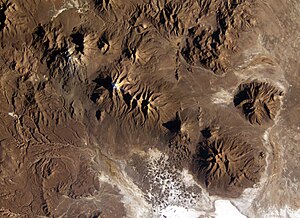Tata Sabaya
| Tata Sabaya | ||
|---|---|---|
|
Tata Sabaya (center right) between the three chain of Cabaraya and the two peaks of Cerro Pariani and Cerro Pumiri (right) (photo of the ISS expedition 9 ) |
||
| height | 5385 m | |
| location | Oruro Department , Bolivia | |
| Mountains | To the | |
| Coordinates | 19 ° 8 ′ 5 ″ S , 68 ° 31 ′ 31 ″ W | |
|
|
||
| Type | Stratovolcano | |
The Tata Sabaya is a 5385 m high inactive stratovolcano in the South American Andes -State Bolivia .
The Tata Sabaya is located on the Bolivian Altiplano at the northern edge of the salt lake Salar de Coipasa in the municipality of Sabaya in the province of Sabaya in Oruro Department . The Tata Sabaya is a peak in a chain of volcanoes, which begins in the west with the Chilean volcano Isluga (5577 m) and extends over the three peaks of Cabaraya (5869 m) and the Tata Sabaya to Cerro Pariani (5077 m).
The time of its creation is unknown, due to its well-preserved external shape it can be dated to the Holocene . The volcano's last activity dates back to 1995, when a small cloud of steam from a fumarole formed over the summit .
The Tata Sabaya presents itself today in a multi-level structure. The basis is a pyroclastic shield volcano , on which a stratovolcano has subsequently settled. The volcano's most noticeable past activity is a 300 km² field of rock debris that extends south from Tata Sabaya. Lava flows from recent history extend over the west and north-west flanks of the volcano, the collapse of the summit has led to deposits mainly on the south-west flank of the mountain.
literature
- Oscar González-Ferrán: Volcanes de Chile . Santiago, Chile: Instituto Geográfico Militar, 1995, ISBN 956-202-054-1 , p. 640 pp. ( spanish )
- Shanaka L. De Silva, Peter Francis: Volcanoes of the Central Andes . Springer-Verlag, 1991, ISBN 3-540-53706-6 , p. 216 pp. ( english )
Individual evidence
Web links
- Tata Sabaya ( English )
- Tata Sabaya in the Global Volcanism Program of the Smithsonian Institution (English)
- Shanaka L. de Silva: Volcanological and petrological evolution of Volcan Tata Sabaya (English)
- Relief map of the Salinas de Garci-Mendoza region 1: 250,000 (PDF; 10.44 MB)


